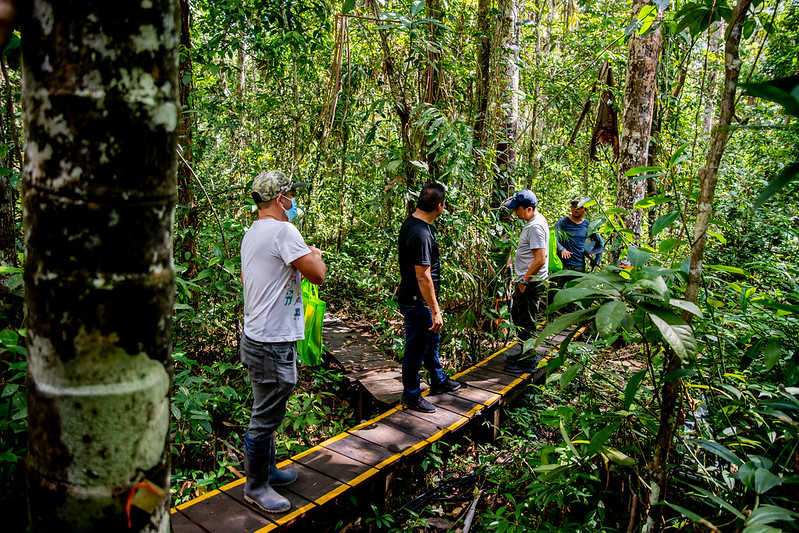Photo by Junior Raborg/CIFOR-ICRAF (CC BY-NC-ND 2.0 DEED)
Imagine that you and a friend sign up to drive for a new ride-sharing startup, with an intriguing perk: You and your friend will each receive a new car at the end of a 30-day period, in exchange for driving for the company.
Your friend, an experienced driver, will also be compensated for his labor during the 30-day driving period. Because you are a relatively new driver, you’re being offered an “incentive” that covers only your first five days of labor; the remaining 25 days are on your own. However, hearing ‘incentive’ motivates you to move forward with the proposal.
After 30 days, you and your friend are both proud owners of a new car. But your friend also has a full month worth of income in his pocket. Is this a fair situation?
Unfortunately, in the world of nature-based emission-reduction projects (i.e., afforestation/reforestation), this scenario plays out all too often. While some tree planting projects are carried out by forest restoration companies, others are being implemented in collaboration with local farmers, landholders, and other community stakeholders.
Those developed and implemented directly and fully by experienced companies regularly identify and cover the total project implementation costs. This includes labor costs related to site preparation, planting, site maintenance, and replanting throughout the duration of the project.
On the other hand, some of those projects implemented in collaboration with local communities cover these costs through “incentives,” which are regularly provided only during the initial years of project implementation.
Nature-based emission-reduction projects are considered as key for development of a carbon market, which will be worth an estimated $50 billion USD by 2030. Yet, these carbon offsetting projects continue to be the target of criticism for their lack of certainty, transparency, accessibility, equitability, and quality.
Benefit-sharing arrangements of carbon-offsetting projects can deepen inequalities by failing to adequately compensate local stakeholders for their contributions.
Benefit Sharing Arrangements
For carbon projects or programs, benefit sharing arrangements define how monetary (i.e., direct payments) and non-monetary (e.g., training, ecosystem services) benefits will be allocated to which stakeholders and how the distribution will take place. The concept of benefit sharing stems primarily from projects related to avoided deforestation and community forest projects (e.g., for conservation). Principles and methods from projects for Reducing Emissions from Deforestation and forest Degradation (REDD+) are mostly translated to other nature-based solution projects.
The relationship between benefit sharing mechanisms and nature-based solution projects for avoided deforestation and conservation, respond to the need to provide incentives for further emissions reductions and results-based finance. In fact, benefit-sharing plans describing the arrangements for the use of finance to create effective incentives to address drivers of deforestation and land use change are an important component of these types of projects and programs. Yet the process of determining who should receive these benefits, and what share of the benefits should be allocated to which stakeholders, can be a complex and tense process. As part of this, the goal of benefit sharing has been to reward local actors for past contributions to emission reductions and removals, and to incentivize future contributions to mitigate climate change by avoiding deforestation and enhancing conservation.
Carbon Offsetting Project Incentives
Following the principles and approaches of benefit sharing mechanisms and arrangements from avoided deforestation and conservation projects such as REDD+, some tree planting project developers have adopted the use of incentives for carbon offsetting projects.
Incentives are regularly set during the initial years of the project to motivate tree planting and successful management (measured by the survival rate of the planted trees) when working with local stakeholders. They are presented as part of the benefits provided in exchange for the carbon sequestration rights originated by the project.
However, for tree planting projects developed and implemented in full by companies, expenses for tree planting and management, specifically in terms of labor, are fully estimated and covered throughout the project realization as part of the implementation costs. Consequently, it is not clear why for some projects the labor for tree planting and management is covered (sometimes partially) and framed as an incentive for only the initial years, while for others it is fully estimated and covered throughout the whole project.
For those working with local stakeholders, the use of an incentive may compel participants to act in a certain way. However, if labor costs aren’t recognized as an incentive in other tree planting projects, then is the word “incentive” properly used in these other cases?
Conclusion
The use of incentives should be carefully considered within the context of nature-based emission-reduction projects. In doing so, it is important to understand and compare how project developers involved in carbon offsetting projects are budgeting and requiring compensation for tree planting and management costs.
The use of the term “incentives” can potentially obfuscate an underlying issue that local stakeholders may not be receiving sufficient payment to compensate for their labor and other project related costs. Moreover, the use of incentives when working with local stakeholders may be misleading or unclear about the implications of participation, including their capability to meaningfully weigh options and give or withhold consent. Given the potential power differential between project developers and local stakeholders, it is critical that project developers provide complete and understandable information to level the playing field to support informed decision making by local stakeholders.
When working in collaboration with local stakeholders, nature-based emission-reduction projects must ensure that the benefit sharing arrangement properly accounts for and transparently compensates local stakeholders for their labor and resources used in planting and managing trees. Payments based on tree survival rates should not be framed as incentives if the project has not properly and fully recognized and paid for the required labor throughout the project realization phase.
Ultimately, an equitable approach to carbon-offsetting projects requires us to value the labor of tree planting and management by project developers and local stakeholders equally.
Juan Robalino is a Climate Change & Land Tenure Specialist with Landesa, the global land rights organzation.

